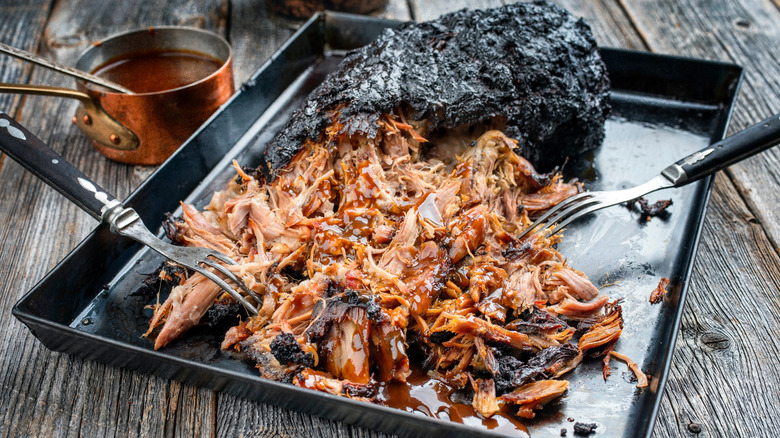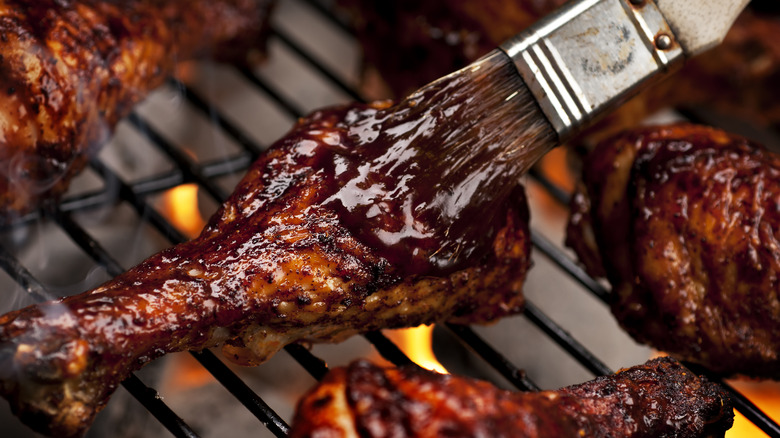The Best Time To Add BBQ Sauce To Pork, Beef, And Chicken
You can apply barbecue sauce to pork, chicken, and beef in a number of ways. Basting or spraying with a watered-down version of barbecue sauce infuses flavor like nothing else. You can also use barbecue sauce as a marinade, you can wait to add it until the end, and you can even use a combination of all three approaches. On top of adding flavor, the barbecue sauce adds moisture, which keeps the meat tender and juicy.
There are a lot of variables at play here, and most of them come down to your preferences. With so many different regional styles of barbecue sauce recognized in the U.S., have fun choosing which one to use first. Don't be shy about making your own either. This tart and sweet pomegranate molasses barbecue sauce is easy to make and elevates any protein with only a few key ingredients.
There is one non-negotiable, however, and that's understanding how basting raw meat with sauce as it cooks can spread bacteria. If you want to use those cute little mops to periodically brush on a barbecue mop sauce, be sure to use a separate dish with new sauce each time you baste. The other solution is a spray bottle. While not as cute, they are just as fun, and there's no cross-contamination involved. No matter what sauce you choose or how you apply it, knowing when to use it on which cut of meat makes all the difference in the world.
Consider the dry rub when adding barbecue sauce to pork
Pork butts have a thicker fat cap (the layer of fat covering the top of the meat) than pork shoulder, which has more muscle, and creating that unforgettable crust with these cuts is key. A dry rub comes in handy to season the fat, which in turn seasons the meat as it melts. You can infuse even more flavor by basting the pork after that divine crust has formed.
Use a few cups of your favorite barbecue sauce mixed with a little water to moisten the pork after it's finished smoking. This compounds flavor and moisture in the pork, adding even more flavor to that perfectly charred bark. Whether you use a Boston Butt or a pork shoulder, you can also smoke it with only a dry rub and add the sauce to the pulled meat. You'll need a cup of barbecue sauce for every five to seven pounds of pulled pork.
With ribs there's one difference. Use a dry rub and brush barbecue sauce on them during the last half hour of cooking so that the sauce doesn't burn. Coat them with a cup of sauce per rack of ribs. Let the sauce cook down into a glaze before they reach 190-200 degrees Fahrenheit, or place them on foil after cooking, brush them with barbecue sauce, and wrap them in the foil to rest. Use this method with chops and loins too.
Try this special barbecue sauce made for chicken only
For moist results with a glorious finish and no burned barbecue sauce, smoke a whole chicken using a dry rub, and then baste it with ½ cup of barbecue sauce fifteen minutes before it's done. It will create the perfect glaze on the chicken if you wait to apply it until about an hour after it's been on the grill. The chicken is done when it registers 165 degrees Fahrenheit on a meat thermometer (about 1½ hours total). Chicken breasts with skin, wings, and legs, cook much faster: about 10 minutes for skin-on breasts, 30 minutes for legs, and 20 minutes for wings. Baste them with sauce during the last 5-10 minutes of cook time.
For skinless chicken breasts, a marinade works beautifully before adding barbecue sauce during the last three minutes of cooking. Grill them directly on a higher heat (400 degrees Fahrenheit) for about six minutes per side. Be sure to pat the meat dry before grilling it. Removing the moisture kickstarts the Maillard reaction and helps make those luscious grill marks. Besides, all that excess marinade will just burn. If you're looking for a show-stopping sauce, this classic, tangy Alabama white sauce recipe turns vinegar, mayonnaise, and a host of other yummy ingredients into a unique barbecue sauce that's out of this world on chicken. Use it as a basting sauce or a finishing sauce, alongside tomato-based and vinegar-based barbecue sauces.
Use barbecue sauce on beef like you would on pork
Add barbecue sauce to beef cuts like briskets and ribs in the same ways you add them to pork. Beef briskets are tough, with a substantial fat cap (that's trimmed down to ¼-½ inch), so a liberal dry rub with either mopping or spraying along with way is a popular path. And while you can make a fine mop sauce from diluting your barbecue sauce of choice with water, you can also try using a mixture of vinegar and barbecue sauce like we do in this recipe for the perfect rack of barbecued ribs.
This method of spraying or mopping on a vinegar-based sauce comes from both Texas and the Carolinas — a genius move that helps break down those tough muscles, turning them into melt-in-your-mouth goodness. Once you learn what makes Texas barbecue sauce bigger and bolder than others, you'll want to try adding some at the end to complement (not overpower) your beef brisket or ribs.
Steaks and burgers can be treated like chicken. These cuts also work well with marinades, or with absolutely nothing besides salt and pepper because, well, it's beef. Glaze these cuts with your favorite tomato or mustard-based barbecue sauces during the last 5-10 minutes of cooking time, and then add a bit more while they're resting.
This Mike's Hard Black Cherry barbecue burger seems like the perfect way to sauce up your next grilling sesh — it's sweet and tart enough to take on any steak too.



